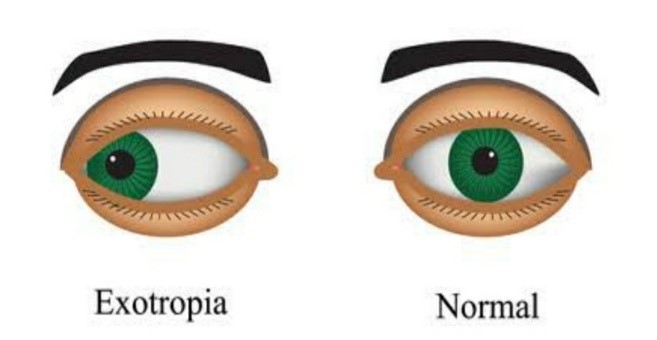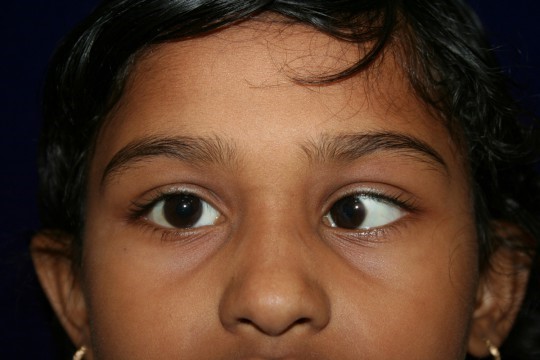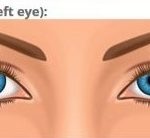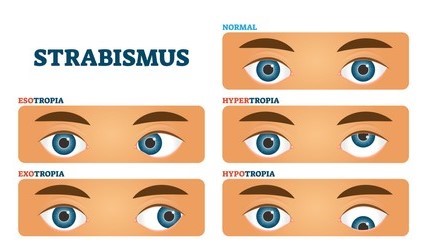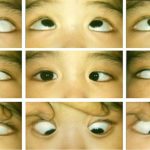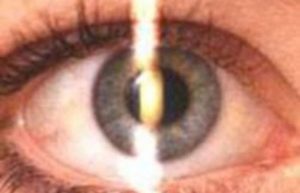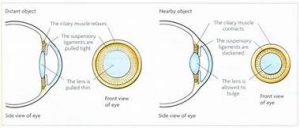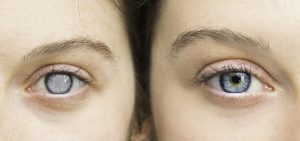Exotropia is a manifest divergent squint, refers to an eye that turns or diverge outwards, while the other eye fixates. It is the opposite of esotropia and usually involves more severe axis deviation than exophoria. It is characteristically seen in older children and adults, and less frequently associated with amblyopia. It can be classified into following clinico-etiological types.
- Congenital exotropia, II) Primary exotropia, III) Sensory exotropia, IV) Consecutive exotropia.
1.Congenital Exotropia–
Congenital exotropia is also infantile exotropia. It is usually presents at birth and almost always presents before six months of age. People with this condition have an outward turning of the eye or eyes from birth or early in infancy.
2.Primary Exotropia-
It may be unilateral or alternating and may present as intermittent or constant exotropia.
- Intermittent exotropia – It is when one eye remains fixated on a target while the other eye drifts outward some of the time. It causes the eye to sometimes move outward, often when you are tired, sick, day-dreaming Or looking in the distance. Other times, the eye stays straight.It is more common in exodeviation. It is of three types-
• Distance exotropia– BSV(Binocular single vision) at near, intermittent or constant exotropia at distance. Suppression normally occurs on divergence. Subdivided into two types- true distance exotropia band stimulatef distance exotropia.
•Near exotropia– BSV for distance, exotropia for near. Common in adults than children.
•Non-specific exotropia– Intermittent exotropia can present in any age group and for either near or distance fixation.
- Constant exotropia – If not treated in time the intermittent exotropia may decompensate to become constant exotropia. It is of two types-
•Early onset exotropia – typically associated with dissociated vertical deviation and manifest latent nystagmus. It is much less common.
•Constant primary exotropia – Exclude secondary exotropia Or decompensating intermittent exotropia. It is rare.
3.Sensory Exotropia – The third common form of exotropia is sensory exotropia. In this case, the eye with low vision is unable to work together with the other eye, and therefore, the poorly-seeing eye may have a tendency to drift outward. It may occur at any age. Most common causes of sensory exotropia are traumatic cataract, corneal opacity, optic atrophy, anisometric amblyopia, retinal detachment and organic macular lesions.
4.Consecutive Exotropia – This occurs when a person who was formerly esotropic becomes exotropic Or, spontaneous conversion of small degree esotropia with amblyopia into exotropia.
Symptoms of Exotropia –
- Loss of vision
- One or both eyes turning outward
- Frequent rubbing of the eyes
- Squinting or covering one eye when looking into bright light or trying to see objects that are far away.
Causes –
- Headache
- Problems reading
- Eyestrain
- Blurry vision
- Poor 3D vision
- Near sightedness

Diagnosis – We have to know about symptoms, family history and other health conditions to make a diagnosis. These can include:
- A comprehensive eye strain.
- An eye alignment test called a cover test.
- A depth perception test .
- A corneal light reflex test.

Treatment –
1.Prescription eyeglasses to correct any refractive error.
2.Placing a patch over the stronger eye to strengthen the weaker eye.
3. Vision therapy, which includes exercises and activities to improve eye align.
4. Some cases of exotropia will require surgery to realign the eye muscles.
